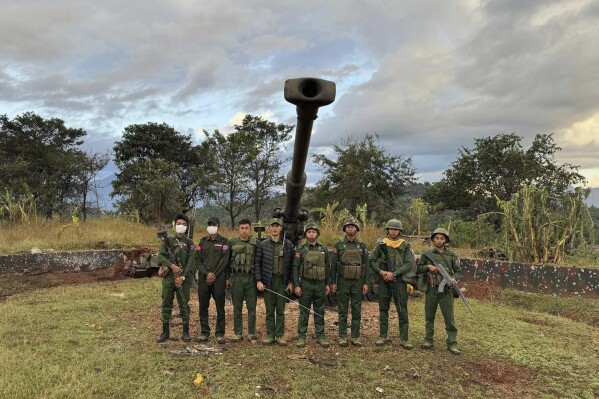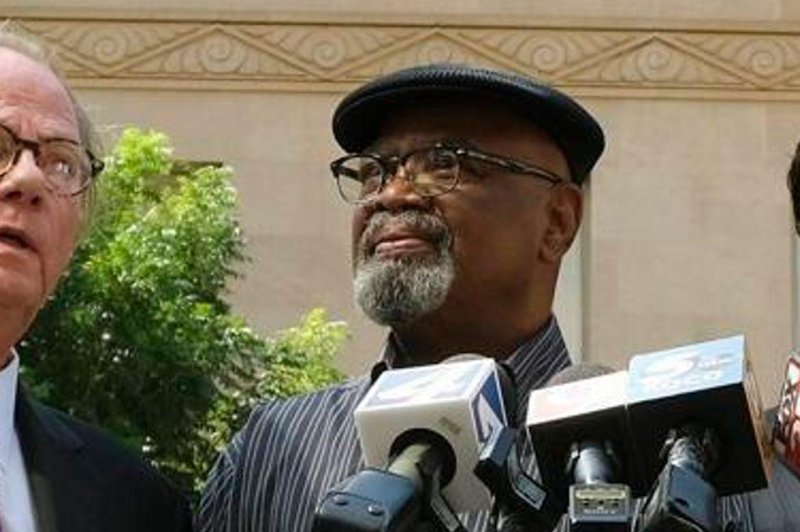UPDATED
Myanmar pro-democracy fighters battle to take state capital
Loikaw (Myanmar) (AFP) – Myanmar pro-democracy fighters in a battered pickup truck drive past abandoned and bombed-out houses in the eastern city of Loikaw, on their way to the front lines of the battle to capture their first state capital from the junta.
Issued on: 02/12/2023

PDFs and allied ethnic minority groups have been battling the Myanmar army for weeks in and around Loikaw
"Our soldiers are from Loikaw township and it's the main reason we are motivated. We all are doing our best with the hope of going back to our homes", said Lin Lin, their leader.
He belongs to one of the dozens of "People's Defence Force" groups (PDFs) that sprung up across Myanmar to fight the military's 2021 coup and are now determined to capture Loikaw and deal a blow to the country's rulers.
PDFs and allied ethnic minority groups have been battling the Myanmar army for weeks in and around Loikaw, a city nestled in lush hills and home to around 50,000 people in eastern Kayah state.
Thousands of residents have already fled air attacks, artillery bombardments and urban battles, PDF fighters said.
Earlier this week, the streets were silent apart from the sounds of sporadic artillery fire.
"At the moment the military is on the defensive," said Lin Lin.
The junta is reeling from an offensive by three ethnic minority groups along the rugged northern border with China
The junta is reeling from an offensive by three ethnic minority groups along the rugged northern border with China that has captured several towns and blocked vital trade routes.
This offensive, dubbed "Operation 1027" after the date it was launched five weeks ago, is the biggest challenge faced by Myanmar's army since it seized power.
Soon after clashes erupted in northern Shan state, other PDF groups opened new fronts in several other states, including Kayah.
Inside Loikaw, footage obtained by AFP shows abandoned houses and shops and streets pockmarked by explosions.
Buildings have been damaged by artillery shells and on some street corners positions fortified with sandbags can be seen.
The military was holed up in the city police station and other buildings, Khun Bedu, the chairman of the Karenni Nationalities Defence Force (KNDF), one of the groups fighting in Loikaw, told AFP.
With ground troops pinned down, the military was relying on its air and artillery strikes to support its troops, Khun Bedu said.
The military "called in airstrikes on us in many places in the town last night", he told AFP on Friday. "We will continue to fight."
The KNDF posted footage two weeks ago that it said showed its fighters receiving the surrender of junta troops who had been holed up in the city's university.
The KNDF and allied fighters have also made several attempts to seize Loikaw's main prison, which have been beaten back, according to the KNDF and the military.
Still 'under control '
Junta chief Min Aung Hlaing said on Wednesday the weeks-long assault on Loikaw had shown "excessive strength".
But he maintained the Loikaw region was "under control".

More than 500,000 people have been displaced across Myanmar since the launch of 'Operation 1027', according to the UN
The United Nations said it evacuated most of its staff from Loikaw last month due to "aerial bombardment of the town and active fighting" in its streets.
In the north, the Arakan Army (AA), the Myanmar National Democratic Alliance Army (MNDAA) and the Ta'ang National Liberation Army (TNLA) have since seized dozens of military outposts.
More than 500,000 people have been displaced across Myanmar since the launch of "Operation 1027", according to the UN.
Around 70 percent of Loikaw's population is thought to have fled in recent weeks, with PDF groups claiming the military had blocked roads and tried to prevent civilians from fleeing the city.
Pro-democracy fighters say they are battling on, spurred by the prize of seizing a state capital in what would be a major victory in their fight against the junta.
Pro-democracy fighters say they are battling on, spurred by the prize of seizing a state capital in what would be a major victory
But some are worried about the cost to their fighters, and to the city itself.
"The military have lost many soldiers and they are weak right now," said Lin Lin.
"We are only afraid of their air strikes."
© 2023 AFP
Myanmar’s military is losing ground against coordinated nationwide attacks, buoying opposition hopes

In this photo provided by the Kokang online media, members of an ethnic armed forces group, one of the three militias known as the Three Brotherhood Alliance, check weapons the group allegedly seized from Myanmar’s army outpost on a hill in Hsenwi township in Shan state, Myanmar, on Nov. 24, 2023. A major offensive against Myanmar’s military-run government by an alliance of three militias of ethnic minorities has been moving at lightning speed, inspiring resistance forces around the country to attack. (The Kokang online media via AP)

In this photo provided by the Kokang online media, members of an ethnic armed forces group, one of the three militias known as the Three Brotherhood Alliance, pose for a photograph in front of weapons the group allegedly seized from Myanmar’s army outpost on a hill in Hsenwi township in Shan state, Myanmar, on Nov. 24, 2023. A major offensive against Myanmar’s military-run government by an alliance of three militias of ethnic minorities has been moving at lightning speed, inspiring resistance forces around the country to attack. (The Kokang online media via AP)

- In this photo provided by the Kokang online media, members of an ethnic armed forces group, one of the three militias known as the Three Brotherhood Alliance, check an army armored vehicle the group allegedly seized from Myanmar’s army outpost on a hill in Hsenwi township in Shan state, Myanmar, on Nov. 24, 2023. A major offensive against Myanmar’s military-run government by an alliance of three militias of ethnic minorities has been moving at lightning speed, inspiring resistance forces around the country to attack. (The Kokang online media via AP)

In this photo released from the The Military True News Information Team on Nov. 8, 2023, Senior Gen. Min Aung Hlaing, chairman of State Administration Council, speaks during a meeting with members the National Defense and Security Council in Naypyitaw, Myanmar. (The Military True News Information Team via AP, File)
BY DAVID RISING
December 1, 2023
BANGKOK (AP) — About two weeks into a major offensive against Myanmar’s military-run government by an alliance of three well-armed militias of ethnic minorities, an army captain, fighting in a jungle area near the northeastern border with China, lamented that he’d never seen such intense action.
His commander in Myanmar’s 99th Light Infantry Division had been killed in fighting in Shan state the week before and the 35-year-old career soldier said army outposts were in disarray and being hit from all sides.
“I have never faced these kinds of battles before,” the combat veteran told The Associated Press by phone. “This fighting in Shan is unprecedented.” Eight days later the captain was dead himself, killed defending an outpost and hastily buried near where he fell, according to his family.
The coordinated offensive in the northeast has inspired resistance forces around the country to attack, and Myanmar’s military is falling back on almost every front. The army says it’s regrouping and will regain the initiative, but hope is rising among opponents that this could be a turning point in the struggle to oust the army leaders who toppled democratically elected Aung San Suu Kyi almost three years ago.
“The current operation is a great opportunity to change the political situation in Myanmar, ” said Li Kyar Win, spokesperson for the Myanmar National Democratic Alliance Army, or MNDAA, one of the three militias known as the Three Brotherhood Alliance that launched the offensive on Oct. 27.
“The goal and purpose of the alliance groups and other resistance forces are the same,” he told the AP. “We are trying to eliminate the military dictatorship.”
Caught by surprise by the attack dubbed Operation 1027, the military has lost more than 180 outposts and strongpoints, including four major bases and four economically important border crossings with China.
Both sides claim they have inflicted heavy tolls on the other, though accurate casualty figures are not available. Nearly 335,000 civilians have been displaced during the current fighting, bringing the total to more than 2 million displaced nationwide, according to the United Nations.
In the latest assault, a coalition of militia forces attacked a town in southeastern Kayin state on Friday, blocking the main road to a key border town with Thailand. Residents said the military responded with artillery and airstrikes.
“This is the biggest battlefield challenge that the Myanmar military has faced for decades,” Richard Horsey, the International Crisis Group’s Myanmar expert, said of the offensive.
“And for the regime, this is by far the most difficult moment it’s faced since the early days of the coup.”
Complicating matters for the military is China ‘s apparent tacit support for the Three Brotherhood Alliance, stemming, at least partially, from Beijing’s growing irritation at the burgeoning drug trade along its border and the proliferation of centers in Myanmar from which cyberscams are run, frequently by Chinese organized crime cartels with workers trafficked from China or elsewhere in the region.
As Operation 1027 has gained ground, thousands of Chinese nationals involved in such operations have been repatriated into police custody in China, giving Beijing little reason to exert pressure on the Brotherhood to stop fighting.
The military, known as the Tatmadaw, remains far bigger and better trained than the resistance forces, and has armor, airpower and even naval assets to fight the lightly armed militias organized by various ethnic minority groups.
But with its unexpectedly quick and widespread losses and overstretched forces, morale is sagging with more troops surrendering and defecting, giving rise to a wary optimism among its diverse opponents.
The current gains are just part of what has been a long struggle, said Nay Phone Latt, a spokesperson for the National Unity Government, the leading opposition organization.
“I would say the revolution has reached the next level, rather than to say it has reached a turning point,” he said.
“What we have now is the results of our preparation, organization and building over nearly the past three years,” he said.
THE OFFENSIVE
The Feb. 1, 2021, seizure of power by army commander Senior Gen. Min Aung Hlaing brought thousands of pro-democracy demonstrators to the streets of Myanmar’s cities.
Military leaders responded with brutal crackdowns and have arrested more than 25,000 people and killed more than 4,200 as of Friday, according to the Assistance Association for Political Prisoners, and U.N. independent investigators earlier this year accused the regime of being responsible for multiple war crimes.
Its violent tactics gave rise to People’s Defense Forces, or PDFs — armed resistance forces that support the National Unity Government, many of which were trained by the ethnic armed organizations the military has fought in the country’s border regions for years.
But resistance was fragmented until Operation 1027, when three of the country’s most powerful armed ethnic groups, the Myanmar National Democratic Alliance Army and the Ta’ang National Liberation Army in northeastern Shan state, and the Arakan Army in western Rakhine state, assembled a force of some 10,000 fighters, according to expert estimates, and rapidly overran military positions.
Sensing weakness and inspired by the early successes of those attacks, the Kachin Independence Army followed by launching new attacks in northern Kachin state, then joined the Arakan Army to help lead a PDF group to take a town in central Sagaing, the heartland of traditional ethnic Bamar support for the Tatmadaw.
In the eastern state of Kayah, also known as Karenni, an alliance of ethnic armed organizations launched their own attacks, beginning a direct assault on Nov. 11 on the state capital of Loikaw, where the Tatmadaw has a regional command base.
In the fierce ongoing fighting for Loikaw, the military is using artillery and airstrikes to pound militia positions.
But Khun Bedu, head of the Karenni Nationalities Defense Force, one of the biggest militias involved in the attack, said it was critical to take the Tatmadaw base.
“We have time, and it is a good opportunity,” he told AP.
Completing the encirclement of Tatmadaw forces, the Arakan Army attacked outposts in its home state of Rakhine in the country’s west on Nov. 13. Their success has been slow, with the Tatmadaw making use of naval power off the west coast to bombard positions, along with concentrated artillery and air strikes, according to a report by the International Institute for Strategic Studies.
Morgan Michaels, who authored the report and runs the IISS Myanmar Conflict Map project, cautioned that the Tatmadaw has been able to concentrate its forces in strong points by abandoning positions and withdrawing, and remains a formidable force.
“It’s not done fighting, and the air and artillery strikes are increasing and becoming more intense,” he said. “So we have to see how that plays out.”
And despite their talk of ridding the country of the military regime, a lot of the fighting is also about the various groups seizing control of territory, especially the MNDAA, which was pushed out of the Kokang area of Shan state, including the capital Laukkaing, more than a decade ago by the military.
“The military could probably end a lot of this with a deal if it needed to,” Michaels said. “It would have to give up something considerable, but I think it could stop the bleeding by giving the MNDAA a considerable concession if they absolutely needed to.”
Still, unlike the civil war in Syria where multiple groups have different and often conflicting objectives, in Myanmar the anti-military groups are not fighting among each other, he said.
“It’s important to emphasize that many groups have the shared goal of either overthrowing or dismantling or severely depleting the capacity of the military regime,” Michaels said.
It was Nov. 15 when the AP first contacted the Tatmadaw captain, reaching him as he was fleeing a position through the jungle near the border town of Monekoe, one of the alliance’s primary targets.
He was able to link up with others, and then led a column back to the Monekoe area to take charge of an outpost on Nov. 22, when he gave the AP a grim assessment of his situation.
“We are surrounded by enemies,” he said, adding that even local army-affiliated militia could not be trusted.
“Here it is difficult to differentiate between who is enemy or friend,” he said.
The captain, who spoke on condition of anonymity for fear of reprisals against himself or his family for talking with the media, said there was not even enough time to eat a meal.
“We have to be always ready in an attack position,” he said as the sound of gunfire and an explosion erupted in the background.
“I can’t keep talking,” he said quickly. “They are coming to attack.”
CHINA’S ROLE
Well aware of Beijing’s irritation over the criminal activity along its border, the Three Brotherhood Alliance underlined as it launched its offensive that it was committed to “combatting the widespread online gambling fraud that has plagued Myanmar.”
Senior Gen. Min Aung Hlaing has tried, unsuccessfully, to turn that on its head and say that the offensive is being funded by the drug trade.
As militia forces have advanced toward the city of Laukkaing, where many of the scam centers were located, their operations have been scattering and many high-level suspects have been captured and turned over to China.
Knowing China’s historic ties to the Brotherhood militias and the influence it wields, supporters of Myanmar’s ruling generals have held several demonstrations in major cities, including in front of the Chinese Embassy in Yangon, accusing China of aiding the militia alliance.
Chinese Foreign Ministry spokesperson Wang Wenbin skirted a question about those allegations this week, instead telling reporters that Beijing “respects the sovereignty and territorial integrity of Myanmar” and reiterating calls for peace.
But Beijing’s actions speak louder than its words, Horsey said.
“If they really wanted the cease-fire, they do have the leverage to enforce one or get pretty far toward enforcing one,” he said. “They haven’t done that, so that’s telling.”
THE CAPTAIN’S DEATH
The AP last made contact with the captain fighting in Shan state on Nov. 23. The call was short.
“I have something to prepare for our outpost,” he said hurriedly. “I will call you back.”
The next call was from a relative on Nov. 25, who said they had been informed he was killed in a night raid on his outpost and buried on site.
It was not clear exactly where the outpost was located, but only one battle was reported in the region that night.
The Brotherhood’s Ta’ang National Liberation Army said its forces attacked a large military outpost in Lashio township on Nov. 23 and took it early the next day.
In its matter-of-fact report, Ta’ang forces said they seized a howitzer, 78 smaller weapons and ammunition, and found the burial site of “more than 50 enemy.”
___
Associated Press writer Ken Moritsugu in Beijing contributed to this story.
___
Follow AP’s Asia-Pacific coverage at https://apnews.com/hub/asia-pacific




